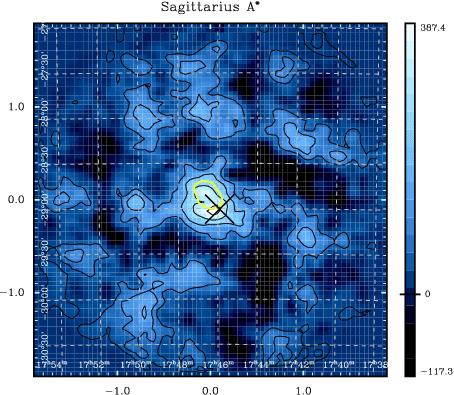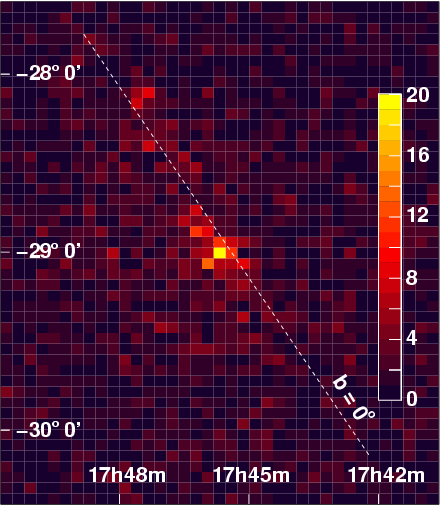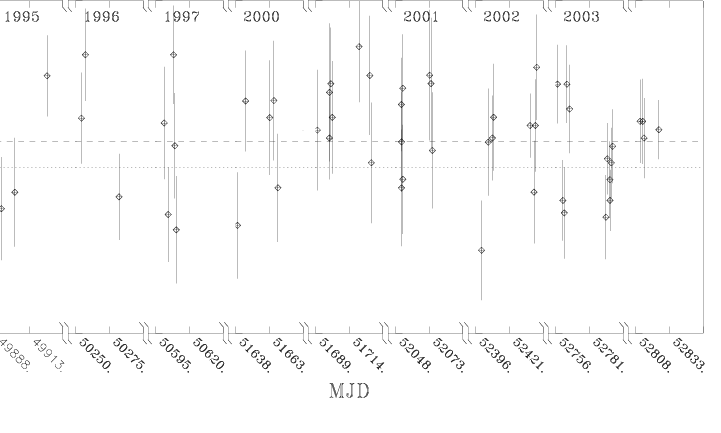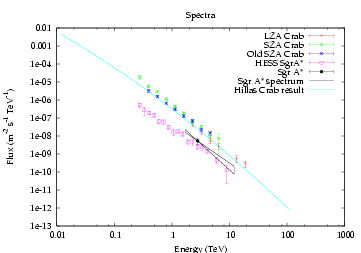
 GCNEWS
GCNEWS
A Newsletter for Galactic Center Research
This Volume was edited by Sera Markoff, Loránt Sjouwerman, Joseph Lazio, Cornelia Lang, Rainer Schödel & Robin Herrnstein
email: gcnews@aoc.nrao.edu

 GCNEWS
GCNEWS


James Buckley
Department of Physics, Washington University, St. Louis, MO
63130, USA
High energy (HE; E > 1GeV) and very-high-energy (VHE; E > 100 GeV) gamma-ray emission has been detected from the Galactic Center (GC) with the EGRET, Whipple, CANGAROO, and HESS experiments. I give an experimentalist's perspective on these results and briefly describe prospects for future observations of the GC at gamma-ray energies. I propose that the current observations may point to as many as three distinct unidentified sources in the GC region. However, the Whipple and HESS results now appear to be consistent in flux and spectrum, and together provide a confirmed detection of a single flat-spectrum source (extending to above 3 TeV) within one arcminute of the position of Sgr A*. To date, the Whipple and HESS observations, provide no evidence for substantial variability over the 10 year period of observations. Future experiments will help to unravel the nature of the high-energy sources; GLAST should be able to clearly pinpoint the position and spectrum of the EGRET unidentified source 3EG J1746-2851 and verify the offset seen in re-analysis of the EGRET data. In the nearer term, HESS should be able to make much more detailed measurements of the angular extent of the source and detect variability, if it exists. When completed in a little over a year, VERITAS should contribute to measurements of the very-high-energy spectrum of the source given its large effective area and good sensitivity at energies above a TeV. Eventually, HESS, VERITAS and CANGAROO should all contribute to coordinated multiwavelength monitoring of Sgr A* and the other sources in the GC region.
Any optical, radio, or X-ray astronomer is well aware of the large number of astronomical objects that can lie within any typical few-arcminute patch on the sky, but for gamma-ray astronomy, where a point-spread function of 0.1 degree is typical, an association is often claimed if a source lies in the general neighborhood of a favorite candidate. As there are very few of the extreme variety of sources capable of producing TeV photons in the entire sky (perhaps 10 at last count) source confusion is usually not a problem; typically the most violent object in the neighborhood is the likely suspect. For AGNs, a clear identification has often been possible by association of the gamma-ray spectral or temporal properties of the source with measurements in the X-ray waveband. In one supernova remnant, SNR RXJ1713.7-3946, a clear association was made based on the resolved gamma-ray image of the source showing a shell morphology that matched the X-ray and radio observations (Aharonian et al. 2004b). However, there are other sources in the Galactic plane where an association has not been possible (to date there are 170 or so EGRET unidentified sources and one TeV unidentified source).
Currently, there are four different detections of GeV-TeV gamma-ray emission from the Galactic Center (GC) region, and many have naturally tried to attribute all of these to a single source (e.g., Sgr A*) or to a single emission mechanism. However, for the time being, all of these detections might better be considered as separate unidentified sources until definitive associations are made. More work is also required to mitigate against potential sources of systematic error in these measurements. Of course observations of the GC are particularly complicated since, in addition to the massive black hole Sgr A*, the GC region contains a dense cluster of stars and compact stellar remnants (including low-mass X-ray binaries and black hole candidates), molecular clouds, and a large structure that may be the remnant of a powerful supernova, Sgr A East (Fatuzzo & Melia 2003).
To anticipate what might be learned from the very-high-energy (VHE) measurements, we can turn to lessons learned from observations of active galaxies and Galactic sources. It is quite possible that in every case that we have detected TeV emission, we have observed photons produced by a single mechanism: inverse-Compton scattering of low-energy photons by high-energy electrons. While a hadronic component (e.g., pi0-decay gamma-rays) might be possible for some of the Galactic sources, there is still no compelling evidence for anything besides a leptonic component. While the VHE production mechanisms may well lack diversity, for many of these sources observation of this new spectral component has provided important new physical constraints on the emission region. In general, the TeV observations have provided much more than an esoteric measurement of the tail of steeply declining power-law spectrum.
For the gamma-ray blazars Markarian 421, Markarian 501, and 1ES1959+650, for example, multiwavelength observations have revealed correlated X-ray and TeV variability and have produced important new information about the nonthermal emission mechanisms at play and about the physical parameters in the relativistic jet (Buckley et al. 1996; Catanese et al. 1997; Fossati et al. 2004). For both Mrk 421 and Mrk 501 it now appears that the VHE gamma-ray emission is cospatial with the source of the rapid X-ray flaring, and that the VHE gamma-ray component is produced by inverse-Compton scattering by the same population of electrons responsible for producing the X-ray synchrotron emission. Thus, the gamma-ray observations provide a separate constraint on the maximum electron energy that can be used to break degeneracies in the physical parameters inferred from the synchrotron component alone. Observations of correlated hour-scale flares indicated magnetic fields of a fraction of a Gauss, and very high Doppler factors ranging from 20-100 (e.g., Buckley 1999). If electrons are accelerated in the vicinity of the GC, VHE gamma-ray observations of a new inverse-Compton component could yield similar constraints.
A number of astrophysical mechanisms could be responsible for the high-energy emission from the region around Sgr A* including: pi0 decay gamma-rays from shock accelerated protons (Fatuzzo & Melia 2003), inverse-Compton scattering by very high-energy electrons accelerated in a super-plerionic wind termination shock (Atoyan & Dermer 2004), high-energy IC emission from electrons accelerated in the accretion disk or by shocks in a (misaligned) jet of Sgr A*.
High-energy gamma-ray observations of the GC are also the subject of particular interest to physicists given the possibility of detecting the signature of annihilating dark matter in the inner halo of our galaxy (e.g., Bergström, Ullio, & Buckley 1998). Sgr A*, at the dynamical center of our Galaxy, may well be surrounded by a cusp or spike in the dark matter halo distribution (e.g., Dubinski & Carlberg 1991; Navarro, Frenk, & White 1996; Gondolo & Silk 1999; Merritt 2003). Annihilation of these hypothetical weakly interacting massive particles (typically, neutralinos) could also contribute to the luminosity in the vicinity of Sgr A* in the radio through gamma-ray waveband. Annihilation of dark matter would be enhanced by a factor proportional to the density squared, and might result in an observable gamma-ray line (from direct annihilation to gamma rays) as well as continuum emission (from secondary products of annihilation to quarks and fermions - Silk & Bloemen 1987; Bergstrom 1989; Giudice & Griest 1989; Jungman & Kamionkowski 1995). The presence of the massive black hole and dense stellar cluster could further steepen the density profile of the dark matter halo, producing very high radio and gamma-ray fluxes that in some cases even exceed the current observational upper bounds (Gondolo & Silk 1999; Merritt 2004; Gnedin & Primack 2004). The details of the halo model on scales < 100 pc and the formation history of the central black hole are critical to predicting the gamma-ray flux, but are, unfortunately, still poorly understood.
The very high-energy extent of the GC spectrum, if it really comes from dark matter annihilation, would point to a very massive neutralino, with rest mass above roughly 10 TeV, beyond the range of theoretical expectations for the likely mass range. While this mass does not yet violate unitarity or other fundamental cosmological constraints, it probably requires a degree of fine tuning in the model parameters that stretches credibility. On the other hand, it is good to keep in mind the wealth of data that point to nonbaryonic dark matter in our galaxy. Measurements of galactic rotation curves and the X-ray emitting gas in clusters point to a dark matter component whose gravitational influence exceeds that of visible matter by an order of magnitude. Self-consistent models of structure formation require cold dark matter, and typically predict a power-law halo density distribution with a central cusp. Primordial nucleosynthesis and recent CMBR measurements point to nonbaryonic dark matter. If we really believe in the existence of abundant nonbaryonic dark matter, it is not unreasonable to expect us one day to detect it.
The EGRET experiment on board the Compton Gamma-Ray Observatory detected a strong (unidentified) source of >100 MeV gamma-rays marginally consistent with the position of the GC (Hartman et al. 1999; Mayer-Hasselwander et al. 1998). More recently, Hooper & Dingus (2002) and Pohl (2004)re-analyzed the higher energy (GeV) gamma-ray data from this source and have found that the most likely position of the EGRET source may be offset from Sgr A*. All three of these results point to a hard spectrum that softens significantly or even cuts off above a few GeV. Both of the new analyses reach similar conclusions that the position of Sgr A* is excluded at the 95% confidence level. Systematic uncertainties in the gamma-ray background models, possible source confusion and limited angular resolution make the analysis of the source in the GC region difficult, however. Nonetheless, Dingus, Pohl, and others from the EGRET instrument team seem confident that at GeV energies such effects should be small, and the offset source position appears to be a solid experimental result. In any event, the GLAST experiment, with its improved angular resolution and sensitivity should make a significant contribution to understanding this region. In particular, the self-vetoing effect that dramatically limited the effective area of EGRET above 10 GeV will not be a problem for GLAST. This should enable GLAST to make use of the larger number of detected GeV photons to better pinpoint and resolve the Galactic Center and to determine the shape of the spectral cutoff.
Imaging Atmospheric Cherenkov Telescopes, like the Whipple, HESS, and CANGAROO ground-based gamma-ray observatories, detect high-energy photons by imaging the flashes of Cherenkov light emitted as gamma-rays interact in the Earth's atmosphere. Imaging Cherenkov telescopes consist of large reflectors (10-13 m diameter) that focus the faint UV/blue Cherenkov flashes onto photomultiplier-tube cameras. These cameras have fields of view of several degrees. Off-line software analysis characterizes each candidate shower image, and separates signal (gamma-ray-like) from background (cosmic-ray-like) events based on the shape and orientation of the Cherenkov images. The event reconstruction determines the point of origin and energy of each gamma-ray event. For the GC observations, both the CANGAROO and Whipple experiments employed a single telescope with a single photon angular resolution of between 0.1 and 0.2 degrees. The HESS observations utilized stereoscopic imaging with two and then four 13-m atmospheric Cherenkov telescopes (as the array came on line). The use of stereoscopic imaging results in a dramatic reduction in background, provides better energy resolution and angular resolution and allows the energy threshold to be substantially reduced (from perhaps 350 GeV for a single 10-m class telescope to 100 GeV for the full HESS array).
CANGAROO (located in Woomera, Australia) and HESS (located in Namibia) are both southern hemisphere instruments, making them well situated for observations of the GC. The GC transits at a very large zenith angle (61o) as seen from the Whipple Observatory (31.7o N latitude). This significantly alters the shower geometry and threshold energy, and requires a modified data analysis procedure. To properly account for the effects of large-zenith-angle (LZA) observations, the Whipple group developed a new set of gamma-ray selection criteria that scale with zenith angle and energy according to empirical scaling laws derived from detailed simulations of large-zenith-angle gamma-rays. The gamma-ray selection criteria were then optimized on contemporaneous observations of the Crab Nebula observed over the same range of zenith angles. The Crab Nebula was used for optimization and calibration because it is a bright, steady gamma-ray source with a known spectrum. This a-priori method was then applied to the GC data and to an independent set of LZA Crab data for normalization.


While the Whipple detection is weak (about a 4 sigma result), the Whipple data on the GC are unique in that they provided the first evidence for a TeV source, and cover a 10 year period from 1994 to 2004. The first hint of a TeV signal from the GC was a 2.5 sigma excess (interpreted as an upper limit) seen in Whipple data taken before 1997 (Buckley et. al. 1997). A positive signal from the source was seen in every subsequent epoch. In the results presented in the Kosack et al. (2004b) paper, all observations of Sgr A* from 1995 through 2003 were combined to obtain 26 hours of ON-source exposure (and 26 hours of matching OFF-source observations at an average zenith angle of 61o). Figure 1 shows the resulting 2-D map of gamma-ray excess with overlaid significance contours. The position of Sgr A* is plotted as a cross in the image. This image shows a 4.2 standard deviation ( sigma ) excess at the corrected center position. To check the robustness of this result, we re-ran the analysis ten times to account for variations due to the Gaussian padding procedure (see below). We found the average significance at the corrected center position is (3.7 +/- 0.13) sigma , somewhat below the initial result. Subsequent to the original result, (Kosack et al. 2004c) included additional data from the 2005 season and performed a more detailed spectral analysis, and more careful calculation of the LZA Crab flux (used for normalization). This more careful analysis resulted in a lower flux (0.2 Crab rather than 0.4 Crab) and flat spectrum. This result will be described in detail in a subsequent VERITAS collaboration paper in preparation. Figure 2 shows the preliminary spectrum (Kosack et al. 2004c) along with the spectrum of the contemporaneous LZA Crab data and the HESS GC result.
The HESS group detected emission consistent with a point-like source of gamma-rays within 1' of Sgr A*. They found that the gamma-ray spectrum was a power-law with spectral index -2.2 +/- 0.09 +/- 0.15 and a flux of 1.82+/- 0.22* 10-7m-2s-1. Figure 1 shows a two dimensional histogram of gamma-ray events detected with HESS around the position of the galactic center. To date the HESS group has not made a definitive statement about a possible extended component along the Galactic plane that may be present in this figure, but new results based on additional data taken with the four-telescope array should be forthcoming (perhaps by the time of the printing of this article.) The HESS result had a high significance (> 9 sigma ) and, together with the Whipple detection, provides the first confirmed high-confidence detection of a TeV source in the GC.
About the same time the Whipple result was first announced (Kosack et al. 2004a) the CANGAROO group announced the detection of the GC at energies above 250 GeV with the CANGAROO-II IACT. This result is essentially identical to the earlier preliminary analysis presented by Tsuchiya et al. (2003) in a poster presentation at the International Cosmic-Ray Conference. The CANGAROO group found the flux to be about 0.1 Crab at 1 TeV, with a very soft spectrum E-4.6+/- 0.5. It is difficult to reconcile this result with the HESS and Whipple results unless this result corresponds to another nearby source, or there is some systematic error in the spectral reconstruction. Significant differences are seen in the HESS and CANGAROO observations of other sources as well. For the time being, it is probably simplest to attribute the CANGAROO detection to some other source.
One particular difficulty in observing the GC with a single atmospheric Cherenkov telescope comes from the considerable difference in sky-brightness between the ON-source region (centered on Sgr A*) and the OFF-source region (used for background subtraction). The diffuse brightness of the Galactic plane as well as light from discrete stars contributes Poisson noise to the Cherenkov images. This excess noise can promote (or demote) image pixels above the analysis threshold and result in a substantial systematic bias in the number of misidentified background cosmic-ray events in the ON and OFF-source regions. To compensate for this bias, the Whipple group uses a technique known as software padding. During a data run, artificial triggers are injected throughout the duration of the ON and OFF-source exposures. These artificially-triggered events, which contain no Cherenkov images, provide a measure of the Poisson fluctuations in the background light. In the subsequent off-line analysis, random Gaussian deviates are added to the corresponding image pixels in the ON and OFF source runs to guarantee that the same amount of noise is present in matching pixels in both runs. After this procedure, only pixels with signals well above the noise level are included in further image processing. This Gaussian padding combined with a high software trigger threshold largely removes systematic biases arising from brightness differences, but increases the energy threshold and decreases the sensitivity. Thus the method reduces systematic errors at a cost of reducing statistical significance; for this reason other groups have typically not employed this method. Neglecting to take this effect into account can have a dramatic effect. For example, when the Whipple group first observed G78.2+2.1 (a supernova remnant in the Cygnus region) we initially obtained an excess of 6 sigma. After the above procedure was applied, the excess vanished and the final result was within one standard deviation of the null hypothesis. Fortunately, telescope arrays such as HESS are largely immune to this bias, due to the improved background rejection and multiple images of a single shower with different parallactic displacements with respect to the background star-light distribution.
To determine the probability for steady emission, a chi2 fit of a constant function was applied to the Whipple GC data and, for comparison, to a series of data taken of Mrk 421 (a source which is known to be highly variable) at a similar zenith angle range as Sgr A*. The total significance of this Mrk 421 data sample was 2.3 sigma . The Sgr A* data yielded a constant count rate of 0.22 +/- 0.05 gamma min-1 with a reduced chi2 of 1.13 (with 54 degrees of freedom), a remarkably good fit considering the changes in the Whipple instrument over the period of observations. The result for Mrk 421 yielded a constant count rate of 0.25 +/- 0.21 gamma min-1 with a reduced chi2 of 3.03 (with 6 degrees of freedom). In this case, there is only a 1.2% chance of obtaining a chi2 value this large or larger if there is no variability. While t his method is by no means statistically rigorous, together with the agreement of the Whipple and HESS results, this analysis provides some indication that the VHE GC source is not dramatically time variable.

I've argued that the EGRET GeV source, CANGAROO detection, and Whipple/HESS source constitute three distinct, as yet, unidentified sources. The Whipple and HESS results now appear to be consistent, and indicate a relatively steady flat-spectrum source with emission extending up above 3 TeV. The HESS results indicate that this source is within 1' of Sgr A*. The high level of apparent brightness 0.2 Crab, at a distance of roughly four times that of the Crab Nebula, qualifies this as an unusually luminous Galactic source. Previous TeV observations of relatively nearby Galactic sources such as X-ray binaries and shell-type and plerionic supernovae have produced numerous upper-limits, or (at best) unconfirmed detections, making the detection of such an object at 8.5 kpc even more unlikely. If the Sgr A East supernova shock were the source of the EGRET gamma rays or the TeV detection, it would have been an unusually intense explosion (Khokhlov & Melia 1996) and a density of 1000 cm-3 and magnetic field of B 0.18 mG (well above the canonical values) would be required (Fatuzzo & Melia 2003). While a typical Galactic source such as an SNR, pulsar, or stellar mass black hole is unlikely, an association with Sgr A* is still a viable possibility and the detection of correlated variability in future gamma-ray and X-ray observations could make the identification compelling. If we associate this emission with either the super-massive black hole Sgr A* or the associated black-hole plerion, for example, the observed emission could come from self-Compton scattering by electrons with energies up to at least 2.8 TeV or from pion-decay gamma-rays from primary protons of even higher energy (kinematics require their energy to be at least several times the maximum gamma-ray energy). The lack of significant variability and the consistency with the GC position allow more exotic possibilities such as the annihilation of very high mass (> 10 TeV) dark matter particles at the GC.

Looking forward to the future, new atmospheric telescope arrays such as HESS, CANGAROO, and VERITAS should make dramatic improvements in our understanding of the complex region in our GC. The HESS Cherenkov telescope array has demonstrated a sensitivity of 1 sigma min-1/2 sqrt(t_min) for a 100 mCrab source at an energy of 100 GeV. When the VERITAS array is complete, we can expect a very similar sensitivity for northern hemisphere sources. While the GC is a southern source it will also be visible with the VERITAS telescope array, currently under construction at Kitt Peak National Observatory in Arizona. At larger zenith angles, the distance to shower-max (the point where the electromagnetic shower reaches its maximum development) increases and the Cherenkov light pool spreads over a larger area. This results in an increase in energy threshold by a factor of about 6, but it also results in an increase in the effective area by a factor of 4. Thus we might expect VERITAS to have an energy threshold of about 600 GeV for the GC, but to have a better sensitivity (per unit observing time) above this energy by a factor of sqrt(4) compared with small-zenith angle HESS observations. As can be seen in Figure 2, the statistical errors of the HESS array and Whipple telescope are comparable above a few TeV. However, the HESS spectral points should be considered of higher quality than the Whipple results, since the improved background rejection afforded by stereoscopic reconstruction means that these results are limited by photon-counting, while the Whipple results are still very much background dominated and therefore susceptible to systematic biases. Clearly stereo reconstruction beats large zenith-angle observations for high-energy sensitivity. But when the VERITAS array is completed in 2006, it might well provide better high-energy sensitivity per unit observing time than HESS, making it a valuable additional component of scheduled multiwavelength campaigns on the GC region.
I acknowledge my graduate student Karl Kosack for all of his hard work on this project, and the entire VERITAS collaboration for their numerous contributions. I also thank Martin Israel for useful discussions about this paper. This work was supported, in part, by the U.S. Dept. of Energy and the National Science Foundation.